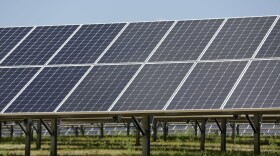Park City, Summit County, Coalville, Francis, Oakley and 14 other Utah local governments are about a year out from launching a renewable energy program.
The infrastructure for that doesn’t exist — yet.
May 13, state utilities regulators gave the 19 local governments — collectively known as the Community Renewable Energy Agency (CREA) — the go-ahead to request bids from contractors to build out a network of renewable energy sources.
“Our solicitation … is seeking solar, wind, hydro, geothermal and also calls for optional co-located battery storage,” Summit County Sustainability Director Emily Quinton said on KPCW’s “Local News Hour” May 21.
Quinton, who sits on CREA’s board, said the agency wants the power sources to be located within Utah, Wyoming or Idaho and will prioritize companies that want to build in Utah.
Fellow board member and Summit County Councilmember Roger Armstrong called it a “gigantic first step.”
“That's one step. We're not across the finish line yet,” he said at the May 14 council meeting. “We still have work to do before the [Utah Public Service Commission] concerning the program design and how it's supposed to work.”
Once built, CREA’s network will be able to connect to Rocky Mountain Power’s energy grid. That will allow customers in those 19 communities to ask for their power to come from a renewable source.
The program is made possible by Utah’s 2019 Community Renewable Energy Act. The levels of investment vary from community to community. Park City and Summit County are among the seven "anchor" communities committed to fully funding the program's $700,000 starting cost.
Customers who opt into the program won’t need to change anything about the way they receive electricity from the grid. But they may pay extra to finance the new solar, wind, hydro or geothermal energy sources.
The way it physically will work is those sources will plug into the entire energy grid and offset the energy use of the customer who selects the “renewable energy” option online or in the mail.
“There is no way to ‘color code’ the electrons so that they go from a specific generation source to a specific customer,” Rocky Mountain Power spokesperson Dave Eskelsen said.
But customers can demonstrate their demand for renewable energy sources, and that they’re willing to pay for it, to Rocky Mountain Power. That’s what CREA plans to facilitate.
Quinton said the CREA board’s goal is for participating customers to only see a $3 to $4 increase on their monthly electricity bill, and that will inform which bids they accept and reject.
She added that the renewable energy centers could dwarf the 100-acre, 80-megawatt solar farm Park City and Summit County recently opened in Tooele County, in partnership with Park City Mountain, Deer Valley Resort and Utah Valley University.
That’s called the Elektron Solar Project, and it’s a separate initiative from CREA but is similarly aimed at offsetting energy consumption.
“[CREA has] a really big range of size of projects that we're interested in evaluating bids for, anywhere between two and 300 megawatts,” Quinton said. “So on the larger end of the spectrum, we could see projects bid that are three times the size of Elektron.”
CREA’s program will be similar to Rocky Mountain Power’s existing Blue Sky program.
Both initiatives fund renewable energy, but CREA wants to offset 100% of participating customers’ energy consumption. Officials call Blue Sky-funded projects “community-scale” and CREA's future projects “utility-scale,” indicating CREA's will be larger.
Summit County and Park City Municipal are financial supporters of KPCW. For a full list, click here.



